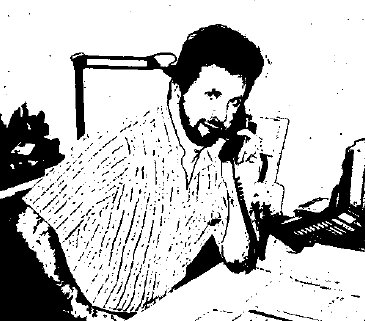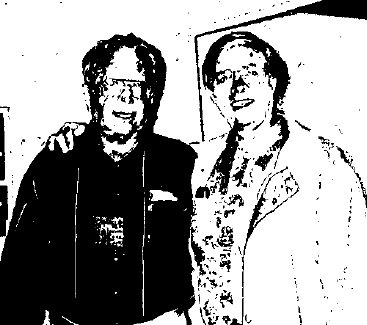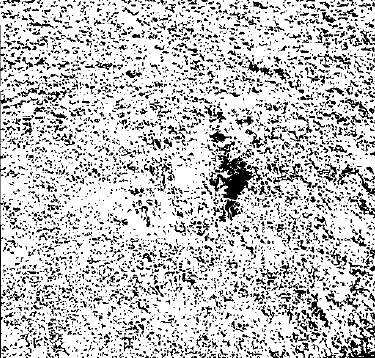Source for this article:
By Thomas J. Carey & Donald R. Schmitt
As the millennium draws inexorably closer, we can look back and see that the 50th Anniversary Year of 1997 witnessed unprecedented interest in the most famous and most thoroughly investigated UFO case of all time: the alleged 1947 crash of a flying saucer near the town of Roswell, NM, and its subsequent retrieval and coverup by the United States military.
Now, two years after those heady days, one may justifiably ask, what has become of Roswell? As the song sung by Peggy Lee laments, "Is that all there is?" No longer on evening news broadcasts, is anything going on, or have things reverted back to where they were prior to the anniversary? That would be a sleepy little desert town proudly proclaiming, "Howdy, from the Middle of Nowhere!" according to one pre-anniversary post card.
Hardly. In the town of Roswell, it can be reported that new motels continue to spring up at a brisk pace to handle the anticipated continuous stream of visitors to the International UFO Museum. Roswell is now included as a "must-see" stop in most tour packages to New Mexico and west Texas solely because of the alleged 1947 incident.
At the UFO Museum itself, besides its own tour office, a growing research library, and a regular schedule of lectures, the exhibits continue to be expanded and updated as new information is developed. Plans for a new multi-million-dollar facility on the edge of town are moving along. Recently, the Museum welcomed its 500,000th visitor.
More and more in the minds of the public, the mere mention of the town's name is becoming synonymous with UFOs. But what of the Roswell Incident itself? Is it over, passe or, less likely, solved? Has the Fat Lady, because of the continued absence of verified "hard evidence," coupled with the passage of so many years, finally sung on this one?
In the Spring of 1998, the two authors met for the first time in several years and agreed on the need to continue an aggressive, proactive Roswell investigation, with an increased sense of urgency since witnesses seemed to be "dropping like flies." At some point in the not too distant future, there will be no first-hand witnesses left to interview.
Even now, we are talking with an increasing number of children and grandchildren of deceased principals. We also felt that the case, as it currently stands, is still incomplete and probably not entirely correct and we are not talking here about Project Mogul, which had and has absolutely no bearing on the Roswell events of July, 1947).
Believing that there was yet more to learn about those long-ago events, the authors agreed to collaborate. As a result, we made two research trips to New Mexico in 1998, one in May and one in October, for the purpose of "mining" for new witnesses and re-interviewing old witnesses.
Contrary to finding a stale, over-plowed landscape populated with well-worn paths and dry holes, we were assuredly impressed by the number of new leads that we were able to obtain, as well as some surprising new twists in the testimony of "old" witnesses.
Right now, we believe that we are on the verge of a new, or at least a modified, Roswell timeline-and in possession of more leads than we can ever hope to follow in our lifetimes, given our present resources. The following is the authors' first collaborative effort, representing our consensus as to where we believe the Roswell investigation will be heading as we approach the new millennium.
No aspect of the Roswell investigation has been more frustrating and less fruitful than the efforts of Roswell investigators to turn up or, in some cases, try to pry loose "a piece" of irrefutable hard evidence with "out-of-this-world" properties that can be traced back to the 1947 incident.
Time and again, hopes are raised only to be dashed when the alleged possessor of such an item cannot or will not deliver at the moment of truth; or the claimed hard evidence turns out to be a complete fiction (or, to be charitable, a "misunderstanding") when the claim is investigated more closely; or when an artifact actually does get into our hands, it turns out instead to be an exotic piece of jewelry.
During the Roswell Anniversary Days of 1997, Derrell Sims and Paul Davids held an all too brief news conference to offer up a piece of metal that they claimed came from the Roswell crash via the all too familiar "unnamed source." They claimed that tests had been performed on the artifact in question which suggested an extraterrestrial origin for it and that, additionally, there were other such pieces then being tested "at respected universities" throughout the land which would no doubt also prove to be of extraterrestrial "etiology." Dr. Roger Leir, a member of that team, assures us that ongoing tests have also proved positive. Unfortunately, in the year-and-a-half since the press conference, Paul Davids has yet to leam the identity of the "unnamed source". Not good.

[Photo caption] Co-author Don Schmitt works the phones at the International UFO Museum and Research Center in Roswell, setting up interviews.

[Photo caption] Co-author Tom Carey, right, with the former Roswell AAF Public Information Officer Walter Haut.
In 1996, paranormal radio talk show host Art Bell came into possession, again from an anonymous source, of small bits and pieces of metal claimed to have come from the Roswell crash. Metallurgical tests were performed, and the bits and pieces of metal, known collectively as "Arts Parts" seemed to be made mostly of aluminum, but with a dash of a few other trace metals for good measure. Is that it? Where do things stand now? It's been three years. More tests? Anybody heard? No follow through. Fade to black. When Roswell researchers obtain a lead that involves claimed physical evidence, all other leads automatically go to the back of the "queue" until the lead is exhausted (unfortunately, usually as indicated above).
However, we are confident that such physical evidence is "out there" somewhere, and one of these days, hopefully, our frustrations will be rewarded. At present, our investigation is in possession of several such leads that we hope will bear fruit:
1. We are presently trying to enlist the cooperation of a first-hand witness who claims to have actually held a piece of something similar to Frankie Rowe's "memory metal" in his hands within the past two years. We have gotten as far as having the witness agree to meet with us personally to try to coordinate with the owners of the artifact to let us examine it. It is quite conceivable that by the time you are reading this we will be meeting with all parties concerned.
2. We know of a retired MP (military policeman) whom we will call "Dutch" who claims to have a piece of the Roswell wreckage stored in his attic for safe keeping and who will supposedly give up the piece to civilian investigators when he dies. But when we talked to him, although in his late 70's, he sounded like he was still in pretty good shape. How long do we sit around and wait and do nothing? (and we are NOT remotely suggesting anything like a Kevorkian intervention here, folks).
3. We have spoken several times to a relative of a well-known Roswell personage who claims to know of parties who have pieces of the Roswell crash material. When pressed further, he identified one of them as none other than himself. When asked for its provenance, he stated that it came, not from the craft, but from "one of the bodies" from the crashed craft and that it is currently being analyzed by degreed professionals in the appropriate forensic fields. He claims that the artifact is not a tissue or fabric sample, but "something else." He plans on going public with this and other Roswell-related "evidence" in his possession in 1999. We shall see.
4. There are several "proactive" steps that we are planning to take to try to secure physical evidence originating from the 1947 Roswell crash. These are in the formative stages at the moment, as each requires resources outside the normal resource-range of most Roswell investigators, including us.
The first project involves a full-scale archaeological "dig" at the Foster/Brazel Ranch, site of the socalled "debris field." Everyone agrees that something came down there in July, 1947, (even the Air Force agrees). The argument, of course, is about just what came down. Archaeological consultants to our investigation have told us that if pieces of whatever came down in Brazel's pasture on that fateful day had lain on the desert floor for even a period as short as one day, there is an excellent chance that rodents would have carried pieces of it into their nests. We know that whatever the debris was, there were many, many small pieces of it scattered, according to Jesse Marcel, over an area 3/4 mi. long by several hundred feet wide. We also know that the material had lain on the desert floor for not one but for at least four days, maybe longer-ample time for eclectic rodents to conduct their business.
Having been to the Brazel site several times, rodent holes as well as small sink holes indeed are in evidence. We are also encouraged to learn from our archaeological consultants that what we seek (whatever it turns out to be) should in all likelihood be waiting for us at a depth of no more than 18 inches in soil that they term, "pack rat midden."
The second project is also located at the debris field site located on the former Foster/Brazel Ranch. A halfdozen or so first-hand witnesses have reported a long, fresh "gouge" or "skid marks" running for some distance amongst the debris that wasn't there prior to July, 1947, the thought being that whatever caused the debris also caused the "gouge."
The "gouge" was reported to have been visible at least for a few years after 1947 by several eye-witnesses, including Bill Brazel, Jr. and Gen. Arthur Exon, who flew over the site in 1949. It is not visible today, having been filled-in by deposits laid down by wind erosion, heavy summer rains, and livestock traffic over the ensuing years, but we know its former location from living eye-witnesses.

[Photo caption:] The former Foster Ranch was pocked with sink holes as this one, each of which could trap small pieces od debris, according to the authors.
We also know from geologists with whom we have spoken that we may be able to obtain a "fingerprint" of the former "gouge," if there ever was such a deformation of the landscape, by using a device known as a "GPR" (Ground Penetrating Radar) which traverses the target area and produces a readout or "fingerprint" of anomalies, depending upon the depth of the strata being diagnosed. Results from such a test would amount to either positive or negative physical evidence, corroborating or not corroborating this aspect of the Roswell Incident.
The problem, of course, is securing the use of a GPR instrument for our purposes. At present, we have an offer from a national laboratory for the loan of such equipment and have had a meeting with a major university to sponsor and participate in such a project.
The former Foster Ranch was pocked with sink holes such as this one, each of which could trap small pieces of debris, according to the authors. versity to sponsor and participate in such a project.
The third project resulted from a "town meeting" that we held in Corona, NM, in October, 1998, seeking informants and/or information relating to the 1947 incident. One of the items to come out of the meeting was confirmation of a story that we had heard before, but could not "pin down. This was a story of a young fellow who lived in the Corona area at the time named Fred Miller (he was killed in Viet Nam in 1967).
Young Fred, according to friends of his, had somehow obtained a number of pieces of the Roswell debris from one of the crash sites and had shown pieces of it around to a number of locals (confirmed by surviving eye-witnesses). As told to us, a piece of the "memory metal" that Fred had in his possession had somehow made its way to the senior prom one June night at Corona High School a year or so after the incident (where, according to eyewitnesses, it was passed around for amusement).
Word had it that Fred "stashed" all of his Roswell material, as well as anything else he did not want others to find in his "personal cave." The problem was, and still is, that there are many, many caves in the Corona area-too many and too dangerous (rattlesnakes like to set up shop in them) to try to examine for our purposes. To cut to the chase, on our most recent trip to New Mexico we were able to identify "Miller's Cave." Do we have any brave spelunkers out there?
Next Month: Part II, Death bed confessions.